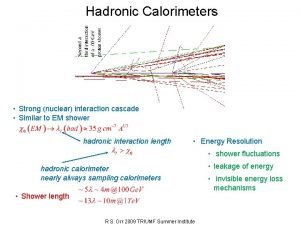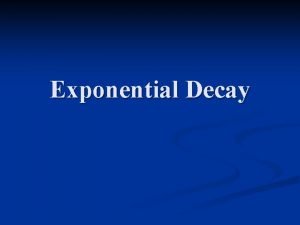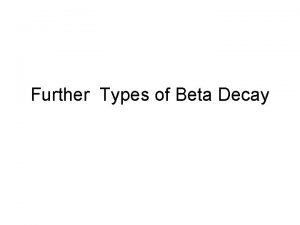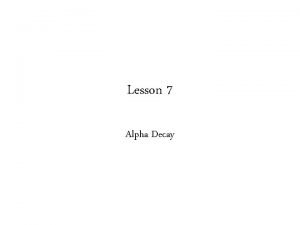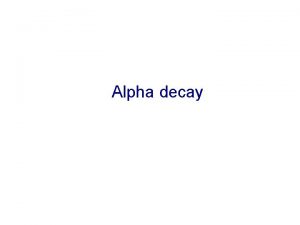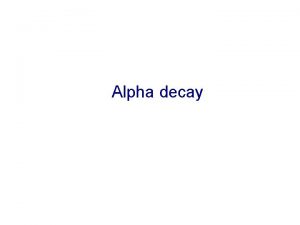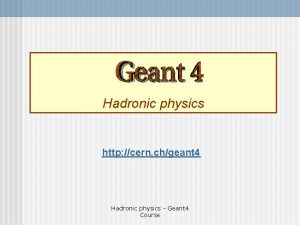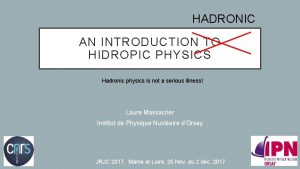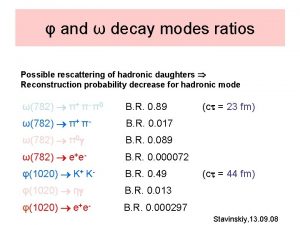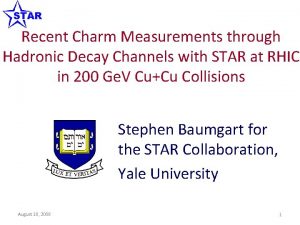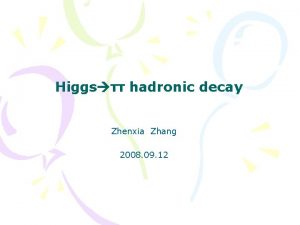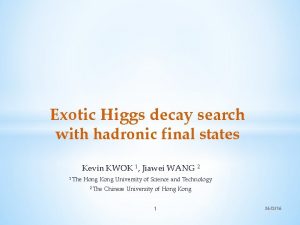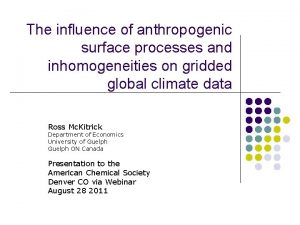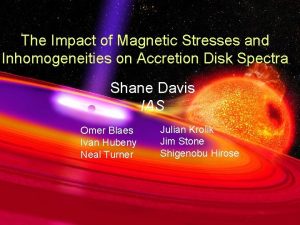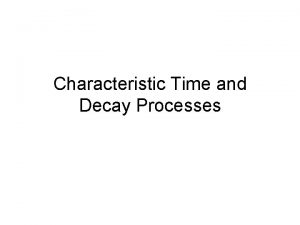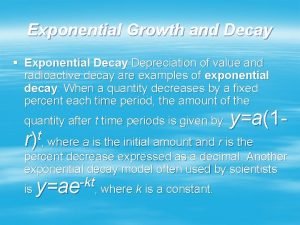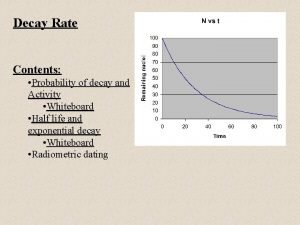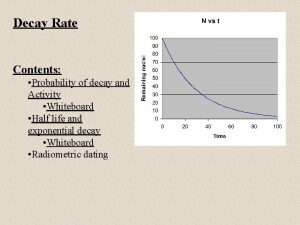The evolution and decay of hadronic inhomogeneities in



















- Slides: 19

The evolution and decay of hadronic inhomogeneities in the early universe Soma Sanyal University of Hyderabad, India (Work done in collaboration with Sovan Sau and Sayantan Bhattacharya) Based on ar. Xiv : 180506241 COSMO 2018 Daejeon, Korea August 27 - 31, 2018.

Plan of the talk q Brief description of baryon inhomogeneities q Previous studies of their decay q Diffusion coefficient of nucleons in presence of muons q Decay of inhomogeneities in multiparticle plasmas q Effect on neutrino chemical potential q Summary q Acknowledgements

Baryon inhomogeneities q q Generated by the trapping of a higher density of baryon number in small regions after the quark – hadron phase transition. They can be formed irrespective of the order of the phase transition

Decay of Baryon Inhomogeneities q q q Decay due to the diffusion of neutrons and protons from higher density regions to lower density regions Decay is important as the neutron/proton ratio is a crucial input to the big bang nucleosynthesis calculations Plasma consists predominantly of leptons, neutrons and protons Previously diffusion of neutrons and protons were studied in such a plasma Collision with muons was neglected as their contribution is considered to be too small

Can we really neglect muons ? q Inhomogeneities formed from collapsing Z(3) domain walls lead to accumulation of a large number of strange quarks q Hadronization of these inhomogeneities result in hyperons q Hyperons decay into pions and muons q Metastable quark nuggets emit kaons which decay to muons

Diffusion Coefficients We calculate the diffusion coefficient of neutrons in the presence of muons ● Since it is a multiparticle plasma, average diffusion coefficient is given by ● ● If N be the total number of particles then

Calculation of Diffusion Coefficients We obtain the diffusion constants from the scattering cross – section of the particles Since both electrons and muons are similar in their interaction with the neutron, the difference in their diffusion constants will be by a factor and the difference in their masses

Calculation of Diffusion Coefficient Differential Cross section of the neutron and the muon is given by The diffusion coefficient is : Here T’ depends on mass of muon Since the net diffusion constant depends on the densities of the particles we keep the density of one particle constant

Density dependency of the diffusion coefficients Neutron density is kept constant Electron density is kept Constant

The Diffusion Length We also calculate the Diffusion length of the neutrons in the nucleon, electron and muon plasma

Decay of overdensities

Decay of overdensities (At constant temperature) Neutron density is kept Electron density is kept constant

Decay of overdensities (As temperature decreases) In Electron Rich Plasma In Muon Rich Plasma

Generation of neutrinos Hyperon decay leads to generation of pions and muons as well as neutrinos Eg : Ω‾ can decay into charged kaon and Λ. The decay of K‾ will generate a νμ Similarly νe can also be generated Chemical potential of the neutrinos are an important input to nucleosynthesis calculations

Neutrino Degeneracy parameters Chemical Potential

Comparison of abundances Muon neutrino > Electron neutrino > Muon neutrinos

Conclusions • Baryonic inhomogeneities decay faster in a muon rich plasma compared to an electron rich plasma • Inhomogeneities generated for scenarios where the strange quarks are selectively filtered will decay before nucleosynthesis • A large muon neutrino degeneracy parameter will make insignificant changes to the production of the primordial elements • However Inhomogeneities which enhances the electron degeneracy factor should be studied further as they affect the primordial abundances significantly

Main References • B. Banerjee and S. M. Chitre Phys. Letts. B 258 247 (1991) • In-Saeng Suh and G. J. Mathews Phys. Rev D 58 123002 (1998) • B. D. Fields, S. Dodelson and M. S. Turner Phys. Rev D 47 4309 (1993) • B. Layek, A. P. Mishra , A. M. Srivastava and V. K. Tiwari, Phys. Rev. D 73 103514 (2006) • A. Atreya, A. Sarkar and A. M. Srivastava, Phys. Rev. D 90 (4) 045010 (2014) • A. Ray and S. Sanyal Phys. Letts. B 726, 83 (2013)

Acknowledgements q q We have used a publicly available standard code of nucleosynthesis based on the Wagoner – Kawano code and modified by S. Dodelson to study the primordial abundances. Department of Science and Technology, India (PURSE Grant)
 Hadronic
Hadronic Hadronic cascade
Hadronic cascade How to find the decay factor
How to find the decay factor Beta minus decay vs beta plus decay
Beta minus decay vs beta plus decay Hình ảnh bộ gõ cơ thể búng tay
Hình ảnh bộ gõ cơ thể búng tay Lp html
Lp html Bổ thể
Bổ thể Tỉ lệ cơ thể trẻ em
Tỉ lệ cơ thể trẻ em Voi kéo gỗ như thế nào
Voi kéo gỗ như thế nào Chụp phim tư thế worms-breton
Chụp phim tư thế worms-breton Chúa yêu trần thế alleluia
Chúa yêu trần thế alleluia Môn thể thao bắt đầu bằng từ chạy
Môn thể thao bắt đầu bằng từ chạy Thế nào là hệ số cao nhất
Thế nào là hệ số cao nhất Các châu lục và đại dương trên thế giới
Các châu lục và đại dương trên thế giới Công của trọng lực
Công của trọng lực Trời xanh đây là của chúng ta thể thơ
Trời xanh đây là của chúng ta thể thơ Mật thư anh em như thể tay chân
Mật thư anh em như thể tay chân Làm thế nào để 102-1=99
Làm thế nào để 102-1=99 độ dài liên kết
độ dài liên kết Các châu lục và đại dương trên thế giới
Các châu lục và đại dương trên thế giới

